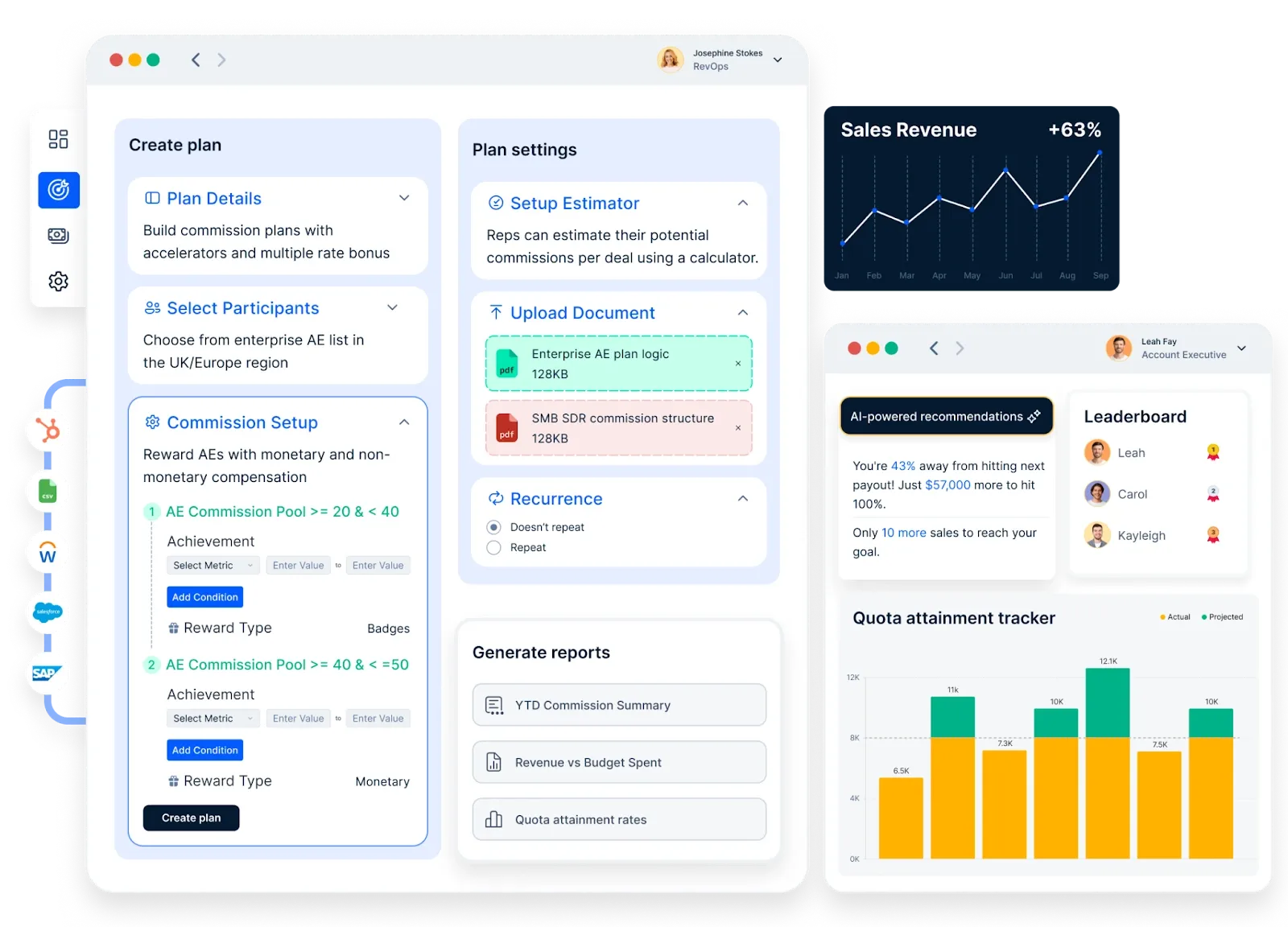Piano di remunerazione SDR: Come creare un piano efficace con esempi
Sapere come progettare piani di remunerazione SDR di successo con la nostra guida passo passo. Esplorate le strategie per motivare il vostro team di vendita.
In questa pagina
I rappresentanti per lo sviluppo delle vendite (SDR) sono il pilastro più importante del team di vendita. Sono responsabili della produzione di lead e di garantire che la coda di vendita sia sempre piena. Concentrandosi sulla ricerca preliminare, sulla verifica dell'idoneità dei lead e sull'interazione con i clienti nelle prime fasi, i rappresentanti per lo sviluppo delle vendite svolgono un ruolo cruciale nel trasformare i lead potenziali in possibilità di vendita.
Tuttavia, le aziende devono creare un piano di retribuzione adeguato che motivi i dipendenti a raggiungere gli obiettivi di fatturato, promuovendo così prestazioni ottimali. Oltre ad aumentare la produttività, i piani retributivi dei DSP ben concepiti favoriscono anche la fidelizzazione, dando ai DSP un senso di sicurezza finanziaria e di dignità.
Lo stipendio medio di base a San Francisco è$67,050con un compenso aggiuntivo in denaro di 26.677 dollari, che porta il compenso totale a 93.727 dollari. Questa interessante struttura salariale riflette l'elevata richiesta di DSP competenti in un mercato del lavoro in rapida evoluzione, che offre sia stabilità che incentivi basati sui risultati.
In questo blog post, impareremo a creare un piano di retribuzione efficace conoscendone i componenti, gli indicatori di performance, i problemi più comuni e le soluzioni per creare un piano di retribuzione SDR di successo.
Queste informazioni vi aiuteranno a creare un piano retributivo per i DSP in grado di sostenere gli obiettivi di espansione della vostra organizzazione, garantendo al contempo equità e ricompensa delle prestazioni.
Comprendere i ruoli e le responsabilità dei DSP
Capire i ruoli speciali dei DSP e come si inseriscono nell'intero funnel di vendita è fondamentale per sviluppare un piano retributivo davvero efficace. I DSP non chiudono le trattative, a differenza dei venditori tipici. Piuttosto, si concentrano su:
- Prospezione:Il processo di identificazione e comunicazione con i possibili clienti attraverso la ricerca.
- Contatto a freddo:Contattare possibili contatti tramite chiamate a freddo o invio di e-mail.
- Qualificazione del lead:Valutazione delpotenziale di un lead come prospettiva di vendita.
- Fissare appuntamenti:Programmare incontri o dimostrazioni di prodotti per gli agenti di vendita per attirare più clienti potenziali.
- Monitoraggio dei lead inbound:Si trattadi contattare i contatti che hanno espresso interesse a fare affari con l'organizzazione, di solito attraverso campagne di marketing o richieste di informazioni sul sito web.
Per la natura del loro lavoro, gli SDR hanno il compito di qualificare i lead, soddisfare importanti indicatori di performance e sviluppare connessioni con i prospect nelle prime fasi del processo di vendita.
Componenti chiave di un piano di compensazione SDR
Conosciamo ora i componenti chiave di un piano compensi SDR che aiuta a motivare i dipendenti.
- Retribuzione di base:È la parte del piano di retribuzione che garantisce al DSP la stabilità finanziaria. Poiché i DSP lavorano in genere in posizioni di livello iniziale o medio, la retribuzione di base deve essere sufficiente a coprire le spese, consentendo loro di concentrarsi sul lavoro senza interruzioni. Di solito, tra il 60% e il 70% del reddito totale di un DSP è generato dalla sua retribuzione di base.
- Retribuzione/commissione variabile:La componente variabile deve fornire incentivi in base al raggiungimento di parametri predeterminati, tra cui il numero complessivo di incontri programmati o di lead qualificati prodotti. Alla retribuzione variabile possono essere associati numerosi indicatori di performance chiave (KPI) che supportano la strategia di vendita complessiva dell'azienda. La retribuzione variabile rappresenta spesso il 30-40% dei guadagni totali nei piani di retribuzione dei DSP.
- Guadagno previsto (OTE):L'OTE, o guadagno totale atteso, è un insieme di retribuzione base e retribuzione variabile che rappresenta ciò che un DSP otterrà una volta raggiunti tutti gli obiettivi di performance. Per evitare malintesi e garantire che i DSP siano consapevoli delle loro responsabilità nell'ottimizzare i profitti, l'OTE deve essere spiegato chiaramente.
- Premi e bonus:Gli incentivi, insieme alla paga base e alle commissioni, possono essere una tecnica molto efficace per aumentare la motivazione dei DSP. In questa categoria possono rientrare i bonus una tantum per il superamento degli obiettivi o il raggiungimento di parametri importanti, come la ricerca di un lead di alta qualità. Per promuovere il lavoro di squadra, i bonus possono essere applicati anche per i risultati conseguiti dall'intero team.
- Periodo di rampa:I nuovi DSP possono impiegare un po' di tempo per mettersi in pari. In questa fase di avvio, l'organizzazione può fornire una commissione minima garantita o una struttura di incentivi, dando ai DSP il tempo di adattarsi senza lo stress immediato di raggiungere grandi obiettivi.
Ecco un esempio che vi aiuterà a comprendere chiaramente tutti i componenti.
Inoltre, XYZ Corp fornisce incentivi, tra cui un bonus di tre mesi per i traguardi raggiunti dall'intero team e un ulteriore bonus di 1.000 dollari per ogni cinque incontri in più rispetto al suo obiettivo. Per i primi tre mesi Jane ha un periodo di rampa in cui, anche se non raggiunge le sue quote, le viene assicurata una commissione di 5.000 dollari per aiutarla a passare al nuovo incarico.
Come progettare un piano di remunerazione equilibrato?
Un piano di retribuzione bilanciato per un Rappresentante per lo Sviluppo delle Vendite (SDR) di solito combina sia la retribuzione fissa che quella variabile. La parte variabile è legata a indicatori chiave di prestazione (KPI) per garantire l'allineamento delle prestazioni agli obiettivi aziendali.
Ad esempio, un SDR di nome John ha uno stipendio mensile di 3.000 dollari come paga base fissa. La sua retribuzione variabile è di altri 1.500 dollari, legati ai seguenti KPI:
- Numero di lead qualificati:40% della retribuzione variabile. Se John genera 20 contatti qualificati in un mese, guadagna 600 dollari. Se supera questo obiettivo, ad esempio generando 25 contatti, guadagna di più, ma se ne genera solo 15, guadagna di meno.
- Attività di chiamata:30% della retribuzione variabile. John deve effettuare 100 chiamate a settimana. Se raggiunge questo obiettivo in modo costante durante il mese, guadagna 450 dollari. Se supera il suo obiettivo di chiamate, può potenzialmente guadagnare di più, ma il mancato raggiungimento dell'obiettivo riduce i suoi guadagni.
- Tasso di conversione:30% della retribuzione variabile. John deve convertire il 10% dei suoi contatti in opportunità. Se raggiunge questo obiettivo, guadagna 450 dollari. Anche in questo caso, il superamento di questo tasso aumenta i suoi guadagni, mentre una performance inferiore li riduce.
In questo piano retributivo, la retribuzione variabile di John è direttamente collegata alle sue prestazioni, mentre lo stipendio fisso garantisce la stabilità finanziaria. Questo equilibrio contribuisce a mantenerlo motivato e ad allineare i suoi sforzi con gli obiettivi di vendita dell'azienda. Ecco un esempio di struttura delle commissioni in formato tabellare basato sui KPI di un SDR:
KPI | Peso | Obiettivo | Commissione per KPI | Struttura della commissione |
Lead qualificati | 40% | 20 contatti qualificati al mese | $600 | - Raggiunge l'obiettivo (20 contatti): $600 |
Attività di chiamata | 30% | 400 chiamate al mese (100 a settimana) | $450 | - Raggiunge l'obiettivo (400 chiamate): $450 |
Tasso di conversione | 30% | 10% di conversione da lead a opps | $450 | - Raggiunge l'obiettivo (10%): $450 |
La retribuzione variabile totale del DSP, pari a 1.500 dollari, è distribuita su tre KPI: Leads qualificati, attività di chiamata e tasso di conversione. Ogni KPI ha un peso prestabilito, che indica il suo impatto sulla retribuzione variabile totale:
- Contatti qualificati: Se il DSP raggiunge o supera l'obiettivo (20 lead), guadagnerà la commissione corrispondente. In caso di prestazioni inferiori, riceveranno una commissione inferiore.
- Attività di chiamata: Il numero di chiamate influenza direttamente la commissione. Obiettivi settimanali coerenti garantiscono un progresso costante verso gli obiettivi mensili.
- Tasso di conversione: La percentuale di lead convertiti in opportunità determina l'entità della commissione percepita. Tassi di conversione più elevati comportano commissioni più alte.
Questa struttura garantisce che ogni parametro di performance venga premiato individualmente e che il DSP abbia chiari incentivi finanziari per ottenere risultati in tutti i KPI.
Oltre a premiare i risultati individuali, i piani retributivi dei DSP ben fatti devono promuovere un avanzamento di carriera a lungo termine. Date un'occhiata a questi passaggi per sviluppare un piano che produca i risultati desiderati:
1. Iniziare con guadagni SDR in linea con l'obiettivo
Il guadagno on-target (OTE) si riferisce al guadagno totale previsto di un DSP se raggiunge il 100% dei suoi obiettivi di performance. Include sia lo stipendio base che la retribuzione variabile. Le aziende utilizzano questa metrica per comunicare le aspettative salariali per i ruoli con una componente di commissioni.
Quando si struttura un piano di remunerazione per i DSP, si inizia con la definizione dell'OTE. Questo approccio garantisce equità, competitività e allineamento al budget. La definizione dell'OTE consente di lavorare a ritroso per creare una struttura retributiva sostenibile.
Metriche chiave da considerare:
- Valore medio del contratto: Quanto vale un cliente medio per la vostra azienda? Considerate le dimensioni dell'accordo e la durata del contratto per determinare un budget ragionevole per l'acquisizione di nuovi clienti.
- Risultati attesi e tassi di conversione: Se disponete di un team SDR, analizzate le loro prestazioni storiche per stimare il numero di offerte che generano annualmente e le attività necessarie per raggiungere tale obiettivo.
- Obiettivi di fatturato: Quali sono le aspettative di fatturato del vostro team di leadership nei confronti del team SDR?
In molte aziende, i DSP contribuiscono per il 30%-40% alle nuove entrate commerciali. Ad esempio, se la vostra azienda mira a generare 12 milioni di dollari di nuove entrate, i DSP dovrebbero apportare circa 3,6 milioni di dollari. Se avete 12 DSP, ognuno dovrà generare circa 300.000 dollari all'anno.
Un rapporto tipico tra quota e OTE si colloca tra 5:1 e 8:1. In base a questa linea guida, l'OTE di un SDR dovrebbe essere compreso tra 37.500 e 60.000 dollari, in linea con gli standard del settore. Tuttavia, queste cifre dovrebbero essere modificate in base alle dimensioni dell'azienda, alla struttura del team, ai prezzi dei prodotti e ad altri fattori rilevanti.
2. Definire il pay mix
Per i ruoli di vendita entry-level, la retribuzione di base costituisce in genere una parte più consistente della struttura retributiva. Un salario di base più elevato garantisce stabilità mentre i DSP sviluppano le loro competenze. Il mix più comune di retribuzione base/variabile per i DSP varia tra 50/50 e 70/30.
I migliori piani retributivi per i DSP raggiungono un equilibrio, consentendo ai DSP di mantenersi con lo stipendio base e garantendo al contempo che le commissioni rimangano un fattore motivante. Se lo stipendio base è troppo alto, i DSP potrebbero non avere la spinta per raggiungere gli obiettivi. Se è troppo basso, la fidelizzazione può diventare una sfida.
3. Scegliere la struttura delle commissioni: Attività vs. risultati
I DSP guadagnano in genere commissioni basate sulle attività o sui risultati. Un piano ben bilanciato spesso incorpora entrambi.
- Compenso basato sulle attività: I DSP ricevono un importo fisso per compiti specifici, come le chiamate effettuate, le riunioni prenotate o i tempi di risposta ai lead inbound. Questo modello funziona bene perché i DSP non chiudono direttamente le trattative.
- Compenso basato sui risultati: I DSP guadagnano una percentuale sulle vendite degli affari da loro originati. Questo li incoraggia a concentrarsi su lead di alta qualità, ma può essere frustrante quando il potere di chiusura non è nelle loro mani.
Un approccio ibrido evita scenari estremi in cui i DSP si concentrano solo sul volume (se pagati sulle attività) o si scoraggiano a causa di fattori incontrollabili (se pagati solo sui risultati). La chiave è allineare gli incentivi ai comportamenti che generano ricavi.
4. Compensazione diversa per gli SDR in uscita rispetto a quelli in entrata
Gli SDR outbound e inbound svolgono ruoli diversi e dovrebbero avere strutture retributive che riflettano le loro responsabilità.
- SDR in uscita: Il loro obiettivo è la ricerca a freddo, quindi gli indicatori chiave di prestazione (KPI) possono includere il numero di chiamate a freddo, di riunioni prenotate o di e-mail personalizzate inviate.
- SDR inbound: Poiché qualificano e gestiscono i lead provenienti dalle attività di marketing, i loro KPI possono includere il tempo di risposta o il numero di incontri qualificati prenotati.
Un solido piano di remunerazione dei DSP deve tracciare il processo di vendita dal primo punto di contatto fino alla conclusione dell'affare. Comprendendo quante attività portano a una singola vendita, è possibile creare un piano che motiva e ricompensa efficacemente i DSP.
Qualsiasi organizzazione può notare una semplificazione dei pagamenti nel proprio piano retributivo, se ben fatto.
Ha implementatoCompass per automatizzare i processi delle commissionifornire visibilità in tempo reale e aumentare il coinvolgimento dei venditori attraverso la gamification.
In meno di 90 giorni, l'azienda ha registrato un'adozione di Compass pari al 68%, un aumento del 36% dei pagamenti e un incremento del 34% dei qualificati agli incentivi, grazie all'implementazione di Compass che ha semplificato i compensi e ha contribuito alla crescita:
- Implementazione di una piattaforma centralizzata:Compass ha fornito una piattaforma centralizzata che ha automatizzato molti aspetti del processo di pianificazione dei compensi.
- Integrazione dei dati:La piattaforma ha integrato diverse fonti di dati, assicurando che tutte le informazioni rilevanti fossero prontamente disponibili e accurate.
Un buon piano di remunerazione per i DSP deve essere vantaggioso sia per il singolo DSP che per l'azienda.È importante progettare un piano che sia realistico e di facile comprensione per mantenere alto il morale e garantire la chiusura di un maggior numero di trattative.La maggior parte delle aziende utilizza un piano di retribuzione variabile per i DSP, che comprende uno stipendio di base più una commissione basata sul rendimento del DSP.
Esempi di piani retributivi SDR
Ecco un paio di piani retributivi per SDR che mostrano le differenze tra i ruoli di SDR inbound e outbound.
1. Rappresentante per lo sviluppo delle vendite in uscita
Categoria | Metrico | Commissione/Incentivo |
Compenso base | Stipendio base | $32,500 per year |
Guadagni in linea con gli obiettivi | OTE (Base + Commissione) | 65.000 dollari all'anno |
Volume di attività | Tocchi significativi (oltre 1000) | $400 |
Tocchi significativi (750+) | $200 | |
Tocchi significativi (sotto i 750) | $0 | |
Qualità della riunione | Riunioni accettate (6+) | 100 dollari per ogni riunione accettata |
Incontri accettati (11+) | 250 dollari per riunione accettata | |
Impatto sulle entrate | Chiuso - Ricavi generati | 2% di tutti i ricavi da vincita chiusa contabilizzati dal DSP |
Obiettivi generali | Tocchi significativi mensili | 750 |
Riunioni mensili accettate | 10 | |
Obiettivo mensile di fatturato chiuso | $75,000 |
2. Rappresentante per lo sviluppo delle vendite in entrata
Categoria | Metrico | Commissione/Incentivo |
Compenso base | Stipendio base | 39.000 dollari all'anno |
Guadagni in linea con gli obiettivi | OTE (Base + Commissione) | 65.000 dollari all'anno |
Risposta del leader | Tempo di risposta (meno di 5 minuti) | 500 dollari per ogni lead |
Tempo di risposta (meno di 10 minuti) | 250 dollari per ogni lead | |
Tempo di risposta (oltre 10 minuti) | $0 | |
Qualità delle opportunità | Opportunità qualificate (5+) | 150 dollari per opportunità qualificata |
Opportunità qualificate (9+) | 250 dollari per opportunità qualificata | |
Impatto sulle entrate | Chiuso - Ricavi generati | 1% di tutti i ricavi da vincita chiusa contabilizzati dal DSP |
Obiettivi generali | Opportunità qualificate mensili | 8 |
Obiettivo mensile di fatturato chiuso | $60,000 |
Creazione di un piano di compensazione SDR con Compass

Un piano retributivo dei DSP che integri gli obiettivi individuali con quelli aziendali e che trovi un equilibrio tra la retribuzione di base e gli incentivi basati sui risultati è considerato efficiente.
Le aziende possono progettare un sistema che favorisca l'espansione del business stabilendo obiettivi chiari, fornendo una remunerazione competitiva e valutando periodicamente la strategia.
Tenete presente che mantenere un piano retributivo che produca risultati mentre la vostra azienda cresce richiede trasparenza e adattabilità. È qui cheCompasspuò aiutarvi. Ecco alcuni modi in cui Compass può aiutarvi con i piani retributivi dei DSP:
- Compass consente di progettare piani di provvigione per qualsiasi KPI o metrica con pochi semplici clic. È possibile gestire facilmente acceleratori, livelli e trigger del flusso di lavoro senza scrivere alcun codice.
- La piattaforma automatizza il calcolo delle commissioni per ottenere pagamenti senza errori per i vostri SDR. Elimina il lavoro manuale e garantisce commissioni sempre accurate.
- Compass offre agli SDR una visibilità in tempo reale della loro pipeline, delle commissioni maturate, delle previsioni e altro ancora. Anche i team di leadership hanno piena visibilità sulle prestazioni e sui pagamenti in tutta l'organizzazione.
Fissate una telefonatacon gli esperti di Compass per scoprire come Compass può ottimizzare la vostra attività.
Domande frequenti
1. Cosa significa OTE in termini di retribuzione SDR?
La retribuzione totale che i DSP possono aspettarsi se raggiungono tutti i loro obiettivi di rendimento è nota come Guadagno su obiettivo (OTE). Di solito consiste nella retribuzione di base più le commissioni.
2. Come viene calcolata la commissione DSP?
Indicatori come le riunioni programmate o i lead qualificati determinano spesso le commissioni per i DSP. Una formula popolare che si aggiunge alla retribuzione variabile è quella di assegnare una commissione per ogni lead o riunione qualificata.
3. Quale percentuale dello stipendio base dovrebbe costituire la retribuzione dei DSP?
In un piano di retribuzione medio dei DSP, la retribuzione di base costituisce il 60-70% del salario totale, mentre la retribuzione variabile basata sui risultati rappresenta il restante 30-40%.
4. Come dovrebbero essere compensati i DSP?
I DSP dovrebbero avere un mix di stipendio base e retribuzione variabile. Un tipico piano di retribuzione dei DSP prevede uno stipendio base (circa il 50-70% del guadagno totale) e incentivi basati sulle prestazioni, legati a metriche chiave come le opportunità qualificate, le riunioni fissate e i ricavi vinti.
5. Qual è il piano di retribuzione dei manager SDR?
I manager SDR hanno di solito uno stipendio base più alto di quello degli SDR, con un guadagno on-target (OTE) compreso tra 90.000 e 140.000 dollari. La loro retribuzione variabile è spesso basata sulle prestazioni del team, tra cui il raggiungimento delle quote, l'impatto sui ricavi e la fidelizzazione dei DSP.
6. Qual è la struttura media delle commissioni per i DSP?
La struttura delle commissioni dei DSP varia, ma in genere comprende:
- Stipendio base da 40.000 a 60.000 dollari
- Commissione basata su riunioni prenotate, opportunità create o entrate chiuse
- Commissione basata sulla percentuale (ad esempio, 1-3% dei ricavi ottenuti).













